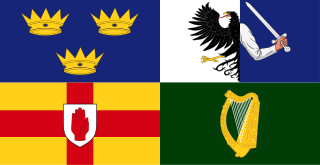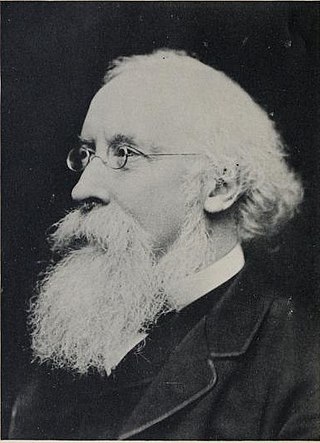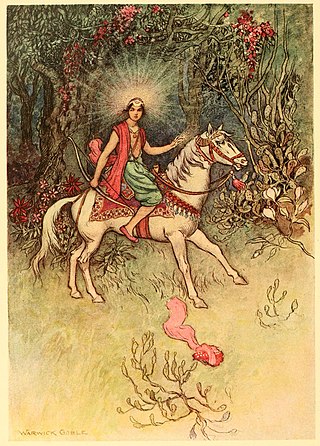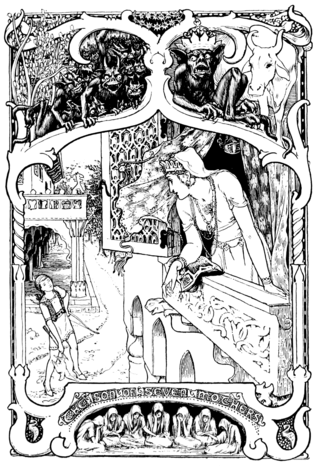Related Research Articles

Aos sí is the Irish name for a supernatural race in Celtic mythology—daoine sìth in Scottish Gaelic—comparable to fairies or elves. They are said to descend from the Tuatha Dé Danann, meaning the 'People of Danu', according to pagan tradition.

A fairy tale is a short story that belongs to the folklore genre. Such stories typically feature magic, enchantments, and mythical or fanciful beings. In most cultures, there is no clear line separating myth from folk or fairy tale; all these together form the literature of preliterate societies. Fairy tales may be distinguished from other folk narratives such as legends and explicit moral tales, including beast fables. Prevalent elements include dragons, dwarfs, elves, fairies, giants, gnomes, goblins, griffins, merfolk, monsters, pixies, talking animals, trolls, unicorns, witches, wizards, magic, and enchantments.

TamLin is a character in a legendary ballad originating from the Scottish Borders. It is also associated with a reel of the same name, also known as the Glasgow Reel. The story revolves around the rescue of Tam Lin by his true love from the Queen of the Fairies. The motif of winning a person by holding him through all forms of transformation is found throughout Europe in folktales.

Whitley Stokes, CSI, CIE, FBA was an Irish lawyer and Celtic scholar.

Merrow is a mermaid or merman in Irish folklore. The term is anglicised from the Irish word murúch.
The Aarne–Thompson–Uther Index is a catalogue of folktale types used in folklore studies. The ATU index is the product of a series of revisions and expansions by an international group of scholars: Originally published in German by Finnish folklorist Antti Aarne (1910), the index was translated into English, revised, and expanded by American folklorist Stith Thompson, and later further revised and expanded by German folklorist Hans-Jörg Uther (2004). The ATU index is an essential tool for folklorists, used along with Thompson (1932)Motif-Index of Folk-Literature.

Mary Louisa Molesworth, néeStewart was an English writer of children's stories who wrote for children under the name of Mrs Molesworth. Her first novels, for adult readers, Lover and Husband (1869) to Cicely (1874), appeared under the pseudonym of Ennis Graham. Her name occasionally appears in print as M. L. S. Molesworth.

"The Witch in the Stone Boat" is an Icelandic folktale, originally collected by Jón Árnason (1864), translated into English in Andrew Lang's fairy tale collection The Yellow Fairy Book (1894).
Ruth Manning-Sanders was an English poet and author born in Wales, known for a series of children's books for which she collected and related fairy tales worldwide. She published over 90 books in her lifetime

"The Peasant's Wise Daughter", "The Peasant's Clever Daughter" or "The Clever Lass" is a German fairy tale collected by the Brothers Grimm in Grimm's Fairy Tales as tale number 94. It has also spread into Bohemia and Božena Němcová included it into her collection of Czech national folk tales in 1846.

Charlotte Eliza Lawson Riddell, known also as Mrs J. H. Riddell, was a popular and influential Irish-born writer in the Victorian period. She was the author of 56 books, novels and short stories, and also became part-owner and editor of St. James's Magazine, a prominent London literary journal in the 1860s.
Le Serpentin Vert is a French fairy tale written by Marie Catherine d'Aulnoy, popular in its day and representative of European folklore, that was published in her book New Tales, or Fairies in Fashion, in 1698. The serpent is representative of a European dragon. His description is: "he has green wings, a many-coloured body, ivory jaws, fiery eyes, and long, bristling hair."
Gangu Teli or Ganga Teli is a king from India belonging to the Teli (oil-presser) caste. He appears in the proverb Kahaan Raja Bhoj, Kahaan Gangu Teli, which is used to compare an important or high-status person to an ordinary or low-status person.
"The Story of Prince Sobur" is an Indian fairy tale. It tells the story of a princess who summons into her room a prince named Sobur, or variations thereof, by the use of a magical fan. The story contains similarities to the European (French) fairy tale The Blue Bird, and variants have been collected from South Asia and in Eastern Africa.

The Boy with a Moon on his Forehead is a Bengali folktale collected by Maive Stokes and Lal Behari Day.
The Three Golden Children refers to a series of folktales related to the motif of the calumniated wife, numbered K2110.1 in the Motif-Index of Folk-Literature. The name refers to a cycle of tales wherein a woman gives birth to children of wondrous aspect, but her children are taken from her by jealous relatives or by her mother-in-law, and her husband punishes her in some harsh way. Only years later, the family is reunited and the jealous relatives are punished. According to folklorist Stith Thompson, the tale is "one of the eight or ten best known plots in the world".

The Son of Seven Mothers or The Son of Seven Queens is an Indian folktale, first published in the late 19th century by author Flora Annie Steel. It is classified in the international Aarne-Thompson-Uther Index as ATU 462, "The Outcast Queens and the Ogress Queen".
Susanna Mary Paull (1812–1888) was a British author and translator who published under the name Mrs. H. B. Paull. She is known for her English translations of the fairy tales of the Brothers Grimm and Hans Christian Andersen and the book Swiss Family Robinson.
The Dead Prince and the Talking Doll is an Indian folktale collected by scholar A. K. Ramanujan in Kannada. It tells the story of a princess destined to marry a seemingly dead man, who is, in reality, under a curse, his body prickled by numerous pins. The princess begins a task of removing the pins to revive the prince, but a servant replaces her and claims the prince's resurrection as her doing. Finally, the princess is given a talking doll she reveals her story to, which alerts the prince of the truth.
References
- ↑ Stokes, Maive S. H. (1879). Indian fairy tales. National Library of Scotland. Calcutta : Privately printed.
- ↑ Silver, Carole G. (2004). "English Fairy Tales and More English Fairy Tales (review)". Marvels & Tales. 18 (1): 105–107. doi:10.1353/mat.2004.0018. ISSN 1536-1802. S2CID 162338275.